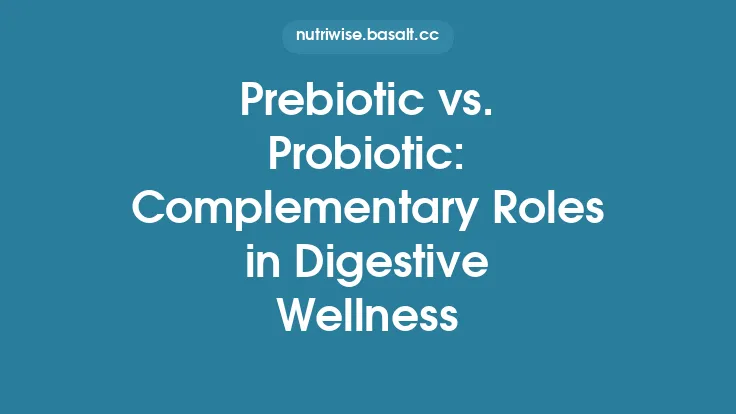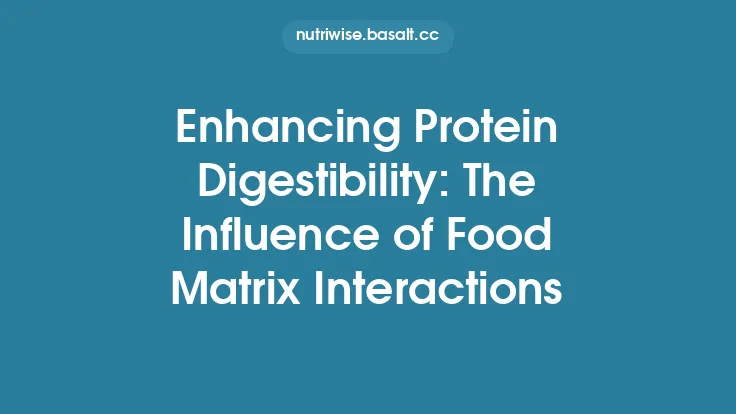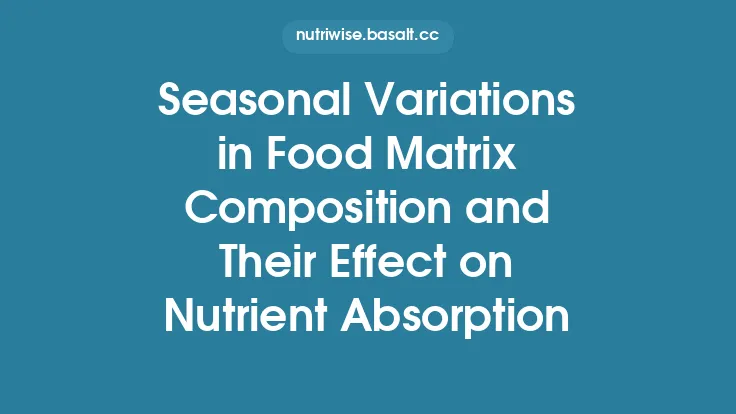The human gastrointestinal tract hosts a dense and dynamic community of microorganisms that continuously interact with the foods we consume. When dietary components that feed these microbes—prebiotic fibers—are paired with live beneficial strains—probiotics—the resulting consortium can profoundly reshape the way nutrients are processed, transformed, and ultimately utilized by the host. This synergy goes beyond simple additive effects; it involves intricate biochemical dialogues, co‑metabolic networks, and host‑mediated regulatory loops that together enhance the efficiency of nutrient extraction from the diet. The following discussion unpacks the principal mechanisms by which probiotics and prebiotic fibers cooperate to optimize nutrient utilization, drawing on decades of research across microbiology, physiology, and nutrition science.
Probiotic and Prebiotic Fundamentals
Probiotics are defined as live microorganisms that, when administered in adequate amounts, confer a health benefit on the host. The most studied genera include *Lactobacillus, Bifidobacterium, Streptococcus, and certain Saccharomyces* yeasts. Their beneficial actions stem from a combination of enzymatic capabilities, competitive exclusion of pathogens, and modulation of host immune and metabolic pathways.
Prebiotic fibers are selectively fermentable substrates that resist digestion in the upper gastrointestinal tract and reach the colon largely intact. Classic examples are inulin‑type fructans, galactooligosaccharides (GOS), resistant starches, and certain oligosaccharides derived from legumes and whole grains. Their selective fermentability means they preferentially stimulate the growth and activity of health‑promoting microbes while sparing potential opportunists.
The pairing of a probiotic strain with a compatible prebiotic—often termed a “synbiotic”—creates a micro‑environment where the prebiotic serves as a dedicated energy source for the introduced probiotic, thereby enhancing its survival, colonization, and functional output.
Synergistic Metabolic Pathways
Cross‑Feeding Networks
In the colon, microbial communities operate through a web of cross‑feeding interactions. Primary degraders break down complex polysaccharides into oligosaccharides, monosaccharides, and short‑chain fatty acids (SCFAs). Secondary fermenters then utilize these metabolites to produce additional SCFAs, gases, and bioactive compounds. When a probiotic strain is introduced alongside a prebiotic that it can directly metabolize, the strain becomes a primary degrader, accelerating the overall fermentation cascade.
For instance, *Bifidobacterium longum efficiently hydrolyzes inulin into fructose and fructooligosaccharides, which are then further fermented to acetate and lactate. These metabolites serve as substrates for butyrate‑producing bacteria such as Faecalibacterium prausnitzii*, which convert acetate into butyrate—a key energy source for colonocytes. The net effect is an amplified production of SCFAs beyond what either the probiotic or prebiotic could achieve alone.
Enzyme Complementation
Probiotic strains often possess a repertoire of carbohydrate‑active enzymes (CAZymes) that complement the host’s limited capacity to degrade certain dietary fibers. By expressing glycoside hydrolases, polysaccharide lyases, and carbohydrate esterases, probiotics unlock otherwise inaccessible carbohydrate fractions. The liberated monosaccharides can then be absorbed directly or further fermented, increasing the caloric yield from the same amount of ingested fiber.
Moreover, some probiotic enzymes act on non‑carbohydrate substrates. For example, certain *Lactobacillus* strains produce proteases and peptidases that hydrolyze dietary proteins into bioactive peptides, enhancing amino acid availability and generating signaling molecules that influence gut motility and satiety.
Modulation of the Gut Microenvironment
pH Regulation
Fermentation of prebiotic fibers yields SCFAs—primarily acetate, propionate, and butyrate—that lower luminal pH. A mildly acidic environment (pH 5.5–6.5) suppresses the growth of pathogenic bacteria that prefer neutral pH, while favoring acid‑tolerant beneficial microbes. This pH shift also influences the ionization state of certain nutrients, subtly affecting their solubility and transport across the epithelium.
Mucus Layer Enhancement
Probiotic activity can stimulate the production of mucin, the glycoprotein backbone of the intestinal mucus layer. SCFAs, especially butyrate, act as signaling molecules that up‑regulate mucin gene expression in goblet cells. A thicker, more robust mucus barrier not only protects the epithelium from mechanical and microbial insults but also creates a diffusion gradient that facilitates the controlled delivery of nutrients to the absorptive surface.
Competitive Exclusion and Niche Occupation
By colonizing adhesion sites on the epithelium, probiotic strains physically block attachment of opportunistic microbes. This “occupancy effect” reduces the likelihood of microbial competition for nutrients, allowing the host’s digestive enzymes and the probiotic’s own enzymatic arsenal to act with fewer interferences. The net result is a more efficient breakdown and uptake of dietary components.
Impact on Nutrient Digestion and Absorption
Carbohydrate Utilization
The combined action of probiotic CAZymes and prebiotic fermentation expands the spectrum of carbohydrates that can be metabolized. Resistant starches, for example, are partially hydrolyzed by *Bifidobacterium* spp. into maltose and glucose, which are then absorbed in the distal small intestine—a region that typically receives limited carbohydrate flux. This extended absorption window can improve glycemic stability without invoking the rapid post‑prandial spikes associated with simple sugars.
Protein and Peptide Bioavailability
Probiotic proteolytic activity can liberate essential amino acids from dietary proteins that are otherwise poorly digested due to anti‑nutritional factors (e.g., trypsin inhibitors in legumes). The resulting free amino acids and short peptides are readily taken up by enterocytes via specific transporters (e.g., PEPT1). Additionally, certain probiotic‑derived peptides exhibit bioactive properties, such as antihypertensive or immunomodulatory effects, further contributing to overall nutritional status.
Lipid Metabolism
While the focus of this article is not on fat‑soluble vitamins, it is worth noting that probiotic fermentation influences lipid handling in the gut. SCFAs, particularly propionate, can inhibit hepatic cholesterol synthesis via down‑regulation of HMG‑CoA reductase, indirectly affecting systemic lipid profiles. Moreover, some probiotic strains produce bile‑salt hydrolase (BSH) enzymes that deconjugate bile acids, altering their reabsorption efficiency and prompting the liver to synthesize new bile acids from cholesterol—a process that can modestly improve lipid utilization.
Microbial Synthesis of Essential Nutrients
B‑Vitamins
Many probiotic bacteria are capable of de novo synthesis of B‑group vitamins, including thiamine (B1), riboflavin (B2), niacin (B3), pantothenic acid (B5), pyridoxine (B6), biotin (B7), folate (B9), and cobalamin (B12). When these microbes colonize the colon, they can release water‑soluble vitamins directly into the lumen, where they are absorbed by passive diffusion or specific transporters. The contribution of microbial vitamin production becomes especially relevant in diets low in animal products, where endogenous synthesis can partially offset dietary gaps.
Vitamin K₂ (Menaquinone)
Certain *Lactobacillus and Bifidobacterium* strains synthesize menaquinone variants (MK‑4 to MK‑13). Vitamin K₂ plays a pivotal role in the activation of γ‑carboxylated proteins involved in calcium handling and coagulation. Although the primary site of vitamin K absorption is the small intestine, colonic production can supplement systemic stores, particularly when dietary intake is limited.
Host‑Microbe Signaling and Transporter Regulation
SCFA‑Mediated Gene Expression
SCFAs act as ligands for G‑protein‑coupled receptors (GPCRs) such as GPR41, GPR43, and GPR109A expressed on enteroendocrine cells and enterocytes. Activation of these receptors triggers intracellular signaling cascades that up‑regulate the expression of nutrient transporters (e.g., SGLT1 for glucose, PEPT1 for di‑ and tripeptides) and enhance the activity of tight‑junction proteins, thereby optimizing nutrient uptake while preserving barrier integrity.
Epigenetic Modulation
Butyrate is a potent histone deacetylase (HDAC) inhibitor. By altering chromatin structure, butyrate can influence the transcription of genes involved in nutrient metabolism, including those governing fatty acid oxidation, gluconeogenesis, and amino acid transport. This epigenetic effect provides a mechanistic link between microbial fermentation and long‑term metabolic programming.
Hormonal Crosstalk
Probiotic‑derived metabolites stimulate the release of gut hormones such as glucagon‑like peptide‑1 (GLP‑1) and peptide YY (PYY). These hormones modulate appetite, gastric emptying, and insulin sensitivity, indirectly affecting how efficiently ingested nutrients are utilized. The synergistic presence of a prebiotic fiber ensures sustained fermentation, prolonging hormone release and reinforcing metabolic benefits.
Clinical and Translational Implications
Enhanced Nutrient Status in Vulnerable Populations
Studies in elderly cohorts have demonstrated that synbiotic supplementation (e.g., *Bifidobacterium lactis* + inulin) improves serum folate and B12 concentrations, likely reflecting microbial synthesis and improved absorption. Similar benefits have been observed in infants receiving probiotic‑fortified formula with GOS, where higher plasma riboflavin levels correlate with reduced incidence of mild anemia.
Support for Athletes and High‑Performance Individuals
Athletes with high carbohydrate turnover benefit from synbiotic regimens that increase SCFA production, thereby providing an additional energy substrate for colonocytes and potentially sparing glucose for muscular work. Moreover, probiotic‑mediated enhancement of protein digestion can aid in muscle repair and growth.
Mitigation of Malabsorption Syndromes
In conditions such as short bowel syndrome or post‑resection malabsorption, targeted synbiotics can augment the residual absorptive capacity by expanding the functional surface area (via mucus thickening) and increasing the availability of fermentable substrates that generate SCFAs, which serve as an alternative energy source for the colon.
Future Directions and Research Gaps
- Strain‑Specific Prebiotic Matching – While broad categories of prebiotics are known to support certain genera, systematic mapping of individual probiotic strains to optimal fiber substrates remains incomplete. High‑throughput screening platforms could accelerate this matching process.
- Metabolomic Profiling of Synbiotic Interventions – Comprehensive profiling of the metabolite milieu (beyond SCFAs) will uncover novel bioactive compounds that influence nutrient transport and host metabolism.
- Longitudinal Impact on Gene Expression – Integrating transcriptomic analyses of intestinal biopsies with synbiotic administration will clarify the durability of transporter up‑regulation and epigenetic modifications.
- Personalized Synbiotic Formulations – Host genetics, baseline microbiota composition, and dietary patterns likely dictate response variability. Machine‑learning models that incorporate these variables could guide individualized recommendations.
Practical Recommendations for Dietary Integration
- Select Complementary Pairings: Choose a probiotic strain with documented capacity to ferment the chosen prebiotic (e.g., *Lactobacillus rhamnosus with GOS, Bifidobacterium breve* with inulin).
- Dose Appropriately: Clinical trials typically employ 10⁹–10¹⁰ CFU per day of probiotic and 5–10 g per day of prebiotic fiber. Adjust based on tolerance and specific health goals.
- Timing Matters: Consuming the prebiotic with meals can enhance its delivery to the colon, while taking the probiotic shortly before or after the meal improves survival through gastric acidity.
- Monitor Tolerance: Gradual introduction of prebiotic fiber (starting at 2–3 g/day) helps mitigate transient bloating or gas, allowing the microbiota to adapt.
- Diversify Fiber Sources: Rotating among different prebiotic fibers (e.g., inulin, resistant starch, GOS) promotes a broader microbial repertoire and prevents over‑reliance on a single metabolic pathway.
By harnessing the complementary strengths of probiotics and prebiotic fibers, nutrition science can move beyond isolated nutrient supplementation toward a systems‑based approach that leverages the gut microbiome as an active participant in nutrient utilization. The mechanisms outlined—cross‑feeding, enzyme complementation, microenvironment modulation, microbial synthesis, and host signaling—form a robust framework for both current dietary strategies and future research aimed at optimizing human health through the gut‑nutrient axis.





